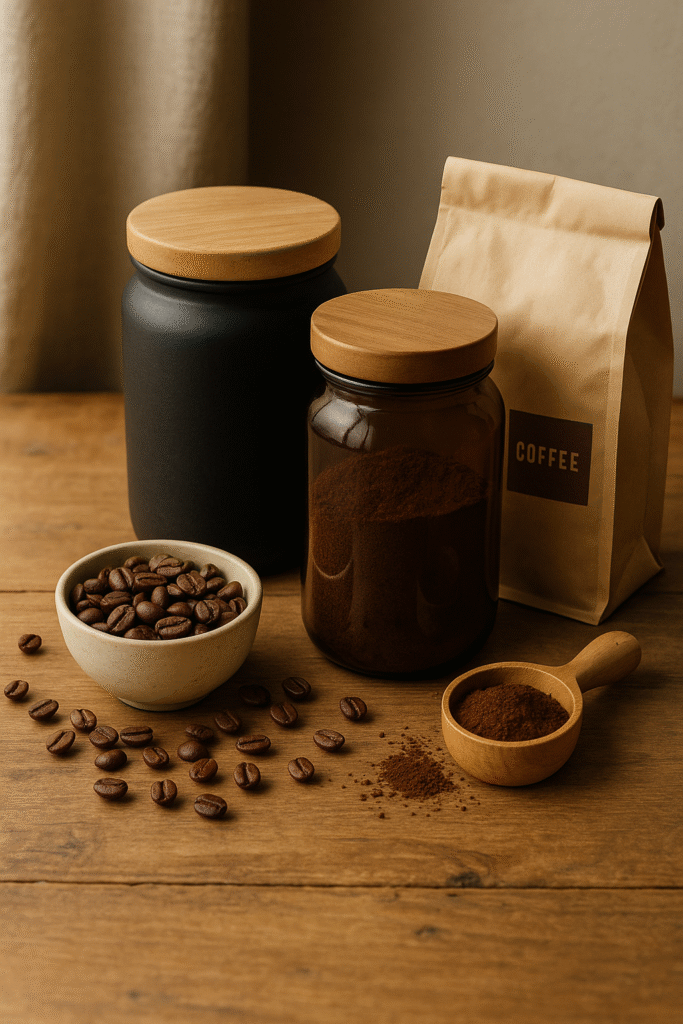For coffee lovers, there’s nothing more disappointing than brewing a cup only to find that the flavor has gone flat or stale. Coffee is a delicate product, and how you store it can greatly influence its taste, aroma, and freshness over time. If you want every cup to be as delicious as possible, proper storage is key. In this guide, you’ll learn the best practices for storing coffee and the mistakes you should avoid.
Why Freshness Matters
Coffee is made up of hundreds of volatile compounds that give it its unique aroma and flavor. After roasting, coffee beans start releasing carbon dioxide and other gases, a process called “degassing.” While fresh beans continue to develop their flavors, they also begin losing quality as they interact with air, moisture, heat, and light.
The longer coffee is exposed to these elements, the faster it becomes stale. Stale coffee tastes flat, bitter, and often unpleasant, losing the complexity and brightness that fresh coffee provides.
The Enemies of Fresh Coffee
To keep coffee fresh, you must protect it from four main enemies:
- Oxygen: Oxidation breaks down coffee’s natural oils and aromatics.
- Moisture: Coffee beans are hygroscopic, meaning they easily absorb moisture from the air, leading to flavor deterioration.
- Heat: High temperatures accelerate chemical reactions that degrade coffee.
- Light: Ultraviolet rays can break down important flavor compounds.
Proper storage aims to minimize exposure to all these elements.
Best Practices for Storing Coffee
1. Store in an Airtight Container
Always store your coffee in an airtight container to prevent oxygen and moisture from getting in. Choose containers made of non-reactive materials like ceramic, stainless steel, or opaque glass. Clear containers, unless kept in a dark place, expose coffee to light, which can damage it.
2. Keep It in a Cool, Dark Place
Avoid storing coffee near the stove, oven, or any place where temperatures fluctuate. A kitchen cabinet or pantry that’s away from heat sources is ideal. Consistent, cool temperatures help slow down the deterioration process.
3. Buy Whole Beans
Whole beans retain their freshness much longer than pre-ground coffee. When you grind coffee, you greatly increase the surface area exposed to air, speeding up oxidation. If possible, grind your coffee just before brewing.
4. Avoid Freezing or Refrigerating Coffee
While freezing can extend the life of coffee in theory, it’s risky for daily use. Freezers introduce moisture and odors that coffee can easily absorb. If you must freeze coffee, do so in airtight bags and thaw only once before use. Refrigeration is not recommended because it creates constant condensation when you remove and replace the container.
5. Buy Smaller Quantities
Instead of buying a large supply of coffee that lasts for months, purchase smaller amounts more frequently. Ideally, buy enough to last you about two to three weeks. This ensures you are always drinking coffee at its peak freshness.
Should You Use Vacuum-Sealed Containers?
Vacuum-sealed containers are excellent for preserving coffee, especially if you buy in bulk. These containers remove air from the inside, drastically slowing down oxidation. However, if you’re drinking your coffee within a couple of weeks, a high-quality airtight container without vacuum features should be sufficient.
The Role of One-Way Valves
Many specialty coffee bags come with a small valve that lets carbon dioxide escape without allowing oxygen in. This is crucial during the first days after roasting when beans are still degassing. Bags with one-way valves are perfect for short-term storage if resealed properly after each use.
Signs That Your Coffee Has Gone Stale
Sometimes it’s obvious when coffee has gone stale, but here are some signs to look out for:
- The aroma is weak or “off”
- The flavor is flat, dull, or bitter
- The body feels thin or watery
- The crema (for espresso) is pale or non-existent
Fresh coffee should have a vibrant aroma and a rich, layered taste.
Special Storage Tips for Different Types of Coffee
- Ground Coffee: Use it as quickly as possible after grinding. Always store in an airtight container.
- Espresso Beans: Since espresso relies heavily on fresh crema and aroma, freshness is even more critical.
- Decaf Coffee: It can deteriorate faster because of the decaffeination process, so be extra cautious with storage.
Myths About Storing Coffee
There are a few common myths about coffee storage that can actually do more harm than good:
- “Store coffee in the fridge to keep it fresh”: False. Refrigerators are humid environments full of odors.
- “Leave coffee in the bag it came in”: Sometimes true if the bag has a one-way valve, but transferring it to an airtight container is often better.
- “Freezing is the best way to store coffee”: Only recommended for long-term storage with proper technique.
Final Thoughts: Protect Your Coffee, Enhance Your Experience
Coffee is a living product that continues to change even after roasting. By taking a few simple storage precautions, you can preserve its flavor and enjoy a consistently great cup every day. Always think about air, moisture, heat, and light — and make sure your storage method protects against all four. When you respect the freshness of your coffee, you get to experience its full potential, from the very first sip to the last drop.
